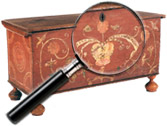|
|
Rolla Sims Taylor
A well-known Texas landscape painter, Taylor (American, 1872 to 1970) studied with Robert Jenkins Onderdonk and Jose Arpa. He was a member of the Southern States Art League, Texas Fine Artist Association, and the American Federation of Artists. He exhibited at the Cotton Carnival (1910), San Antonio Art Guild, San Antonio Competitive Exhibitions, and the Texas Federation of Womens Clubs. His work is included in the collections of the Panhandle-Plains [...] Click here to continue reading.
Anna Heyward Taylor
A descendant of a wealthy cotton planting family from Columbia, South Carolina, Anna Heyward Taylor had a grandfather who owned one of the largest cotton plantations in the State. In 1929, she moved to Charleston permanently and became known for her woodblock prints of women flower vendors, usually posed against an historical structure of the city.
Taylor was one of the Charleston Renaissance group of artists, active between 1915 and [...] Click here to continue reading.
Tasha Tudor Costume Collection
Following are 1) a letter from Tasha Tudor, 2) a letter from Edward F. Maeder, Curator of Textiles, Historic Deerfield, and 3) a letter from Karen Augusta, Whitaker-Augusta Auction Co. All regarding the historic costume collection of Tasha Tudor.
April 19, 2006
Karen Augusta Charles A. Whitaker Auction Company 1002 West Cliveden Street Philadelphia, PA 19119
Re: Collection of Costumes
Dear Ms. Augusta:
You had asked for information regarding [...] Click here to continue reading.
Edmund Charles Tarbell (1862-1938)
Edmund Charles Tarbell was born in 1862 and raised in Dorchester, Massachusetts. At age 15, he began a three year apprenticeship at Forbes Lithographic Company. He then attended the Boston Museum School and the Academie Julian in Paris. In 1886, he moved to New York and became a member of the Society of American Artists. He broke from that society in the 1890′s when he joined The Ten, a group [...] Click here to continue reading.
Reuben Tam (1916-1991)
Landscape painter, educator, and graphic artist, Reuben Tam has been described as a man of two islands because he was born and spent much of his adult life in Kapaa, Hawaii and spent most of his summers on Monhegan Island, Maine. He was also known as an artist who interpreted the moods of nature. He earned a BA degree from the University of Hawaii in 1937, and also studied at the [...] Click here to continue reading.
William Henry Fox Talbot (1800-1877)
Noteworthy for the early appearance of a photographic print in a periodical, a Talbotype, or “sun picture,” commonly known as a calotype. William Henry Fox Talbot, began experimenting with capturing images on light-sensitive paper around 1834, and patented the calotype, also called a Talbotype, in 1840. It was the first instance of a photograph secured on paper and produced with paper negatives, which allowed for multiple copies of the [...] Click here to continue reading.
Arthur Fitzwilliam Tait (1819-1905)
Arthur Fitzwilliam Tait was one of the foremost animal and sporting scene painters of 19th century America. Born August 5, 1819 near Liverpool, England, Tait moved to Manchester as a youth and learned the techniques of lithography while working for an art dealer in that city. By 1838 he identified himself as an artist and had a rising reputation as a lithographer and illustrator of popular magazines. According to one [...] Click here to continue reading.
Quincy Tahoma (Navajo, 1921-1956)
Quincy Tahoma had a short career, and, after his tragic accidental death at the age of 35, became highly published. Tahoma attended the Albuquerque Indian School from 1936 to 1940 and the Santa Fe Indian School for post-graduate studies. His early work mostly consisted of tranquil scenes of Navajo life, but he eventually changed, and began illustrating gruesome depictions of war and hunts.
Today his work is found in the [...] Click here to continue reading.
Margaret Tafoya (1904 to 2004)
A Tewa Pueblo Indian who gained international fame for her stunning black and red pottery, Margaret Tafoya never used a potter’s wheel or other innovations. Born in 1904, she was the matriarch of Santa Clara Pueblo potters, who are more numerous and produce more pottery than those of any other pueblo. Her mother, Sara Fina Gutierrez Tafoya, or Autumn Leaf, was “undoubtedly the outstanding Tewa potter of her time,” [...] Click here to continue reading.
Agapita Silva Tafoya (1904-1959)
Agapita Silva Tafoya (1904-1959) was the sister-in-law of Margaret Tafoya and wife of Camilio Tafoya. Although not prolific, she was mother to a family of potters, including Grace Medicine Flower. Her work was shown in the 1974 Seven Families in Pueblo Pottery exhibit at the Maxwell Museum of Anthropology, University of New Mexico.
Information courtesy of Cowan’s Auctions Inc., March 2007
|
Recent Articles
- Charles Alfred Meurer – American Artist & Tromp L’Oeil Artist
- Sendak, Maurice – American Artist & Writer
- Godie, Lee – American Artist
- Davis, Vestie – American Artist
- Bartlett, Morton – American Artist
- Mackintosh, Dwight – American Artist
- Evans, Minnie Jones – African-American Artist
- Mumma, Ed (Mr. Eddy) – American Artist
- Nice, Don – American Artist
- Savitsky, John (Jack) – American Artist
- Gordon, Harold Theodore (Ted) – American Artist
- Dial, Thornton – African-American Artist
- Doyle Sam – American Artist
- Johnson, Lester Frederick – American Artist
- Finster, Howard – American Artist
|
|
